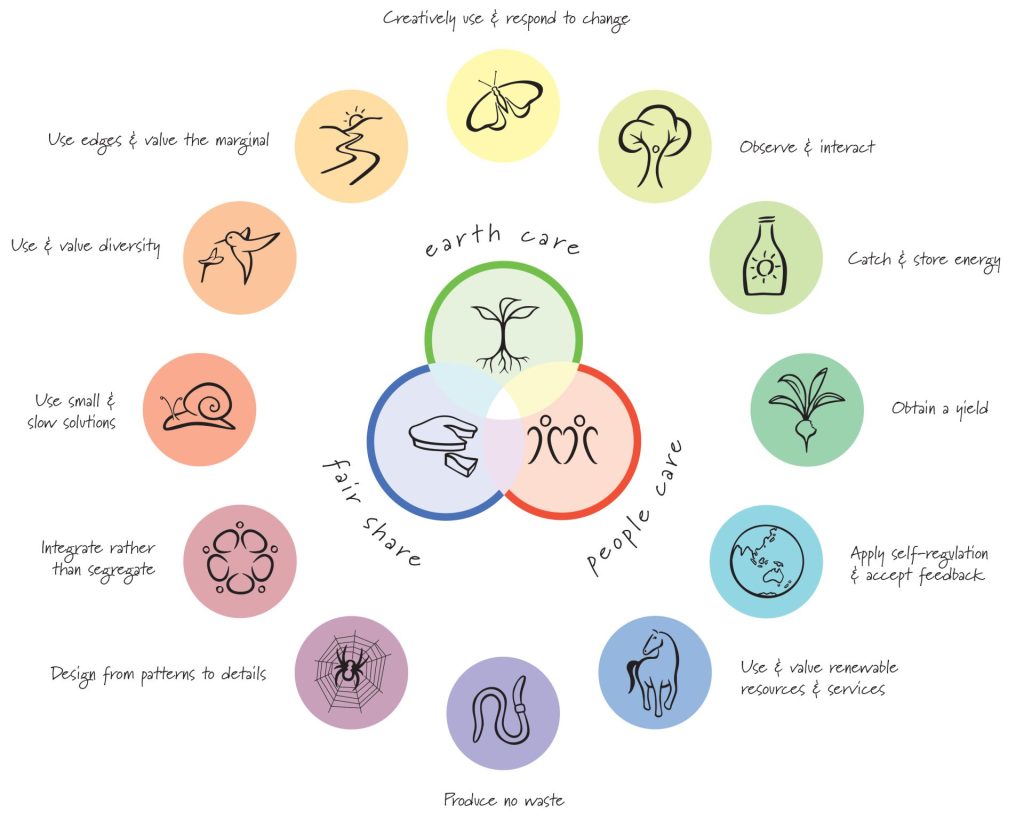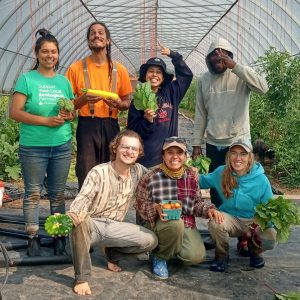What are the 12 Principles of Permaculture?
There are 12 basic standard principles of permaculture design. Whatever resource you look at they are all the same.

(Source: permacultureprinciples.com – Creative Commons license CC BY-NC-ND 2.5 AU)
By following these principles, we can create systems that are not only sustainable but regenerative—providing for human needs while restoring the health of the planet.
1. Observe and Interact
Observation is key. Before we make any changes, we must first understand the environment we’re working with. By carefully observing nature—how water moves, where the sun shines, what wildlife visits—we can create designs that work with natural systems instead of against them.
For example, if you observe the patterns of sunlight in your garden, you can plant crops that need full sun in the right locations.
2. Catch and Store Energy
Permaculture teaches us to capture energy when it is abundant and store it for future use. Energy comes in many forms—sunlight, rainwater, biomass, or even human labor. By catching and storing these, we build resilience into our systems.
A practical example is installing rainwater tanks to store water during the rainy season, which can be used during dry periods.
3. Obtain a Yield
Every permaculture system should provide a tangible yield—whether that’s food, energy, or resources. This principle reminds us that sustainable systems need to be productive, offering something valuable to humans while maintaining the health of the ecosystem.
For instance, planting a diverse food garden ensures that you’re not only feeding yourself but also enriching the soil and supporting local biodiversity.
4. Apply Self-Regulation and Accept Feedback
Nature is constantly giving us feedback, and it’s important to listen. This principle encourages us to observe the results of our actions and adjust as needed. By applying self-regulation, we prevent problems from escalating and ensure that our systems remain sustainable.
For example, if you notice that your garden soil is becoming compacted, you can introduce more organic matter to improve its structure.
5. Use and Value Renewable Resources and Services
Permaculture prioritizes renewable resources over finite ones. By using resources like sunlight, wind, rainwater, and plants—rather than fossil fuels or chemicals—we reduce our impact on the planet and create systems that can sustain themselves indefinitely.
Solar panels, for instance, harness the power of the sun, providing renewable energy for your home or farm.
6. Produce No Waste
In nature, there is no such thing as waste—everything is recycled and reused. In permaculture, we strive to create closed-loop systems where resources are continually cycled. Composting, for instance, turns kitchen scraps into valuable soil nutrients, reducing waste while improving soil health.
By designing for efficiency, we ensure that nothing goes to waste, whether it’s food, water, or energy.
7. Design from Patterns to Details
Nature is full of patterns, from the way leaves grow to the structure of rivers and landscapes. This principle encourages us to recognize and use these patterns to guide our designs. Once we understand the big picture, we can then focus on the details.
For example, the flow of water through a landscape may inspire the placement of swales and ponds to manage water effectively.
8. Integrate Rather Than Segregate
In permaculture, integration is key. Rather than isolating different elements (like animals, plants, and people), we design systems where they work together in harmony. By placing elements in beneficial relationships, they can support each other.
For example, chickens in a permaculture garden can provide pest control, fertilize the soil, and even turn compost, reducing the need for human labor.
9. Use Small and Slow Solutions
Big, fast solutions often lead to more problems. In contrast, permaculture advocates for small, slow solutions that are easy to maintain and adapt over time. These smaller changes are often more sustainable and easier to implement.
Instead of transforming your entire garden in one season, you might start with a small herb patch and slowly expand as you learn more about your site’s needs.
10. Use and Value Diversity
Diversity increases resilience. In permaculture, we embrace biodiversity in plants, animals, and even human activities. A diverse system is better able to withstand challenges like pests, diseases, or climate change.
In your garden, this might mean planting a variety of crops instead of relying on a single one, ensuring that if one fails, others will thrive.
11. Use Edges and Value the Marginal
Edges—the places where different systems meet—are often the most productive and dynamic areas in an ecosystem. By using the edges and valuing the marginal, we can tap into new opportunities for productivity.
For example, the edge between a forest and a field, known as an “ecotone,” is often richer in biodiversity than either of the systems alone.
12. Creatively Use and Respond to Change
Change is inevitable, both in nature and human systems. This principle encourages us to be creative in our responses to change, using it as an opportunity to improve our systems rather than seeing it as a problem.
For example, as climate change alters weather patterns, we might adapt our gardens to include more drought-tolerant plants or incorporate rainwater harvesting systems.
Applying the Principles in Your Life
These 12 principles serve as a flexible toolkit for anyone looking to implement permaculture in their life, whether that’s in a garden, a community project, or a business. The beauty of permaculture is that these principles are adaptable and can be applied at any scale, making sustainability accessible to everyone.
Resources:
Permaguide
World Permaculture Association



